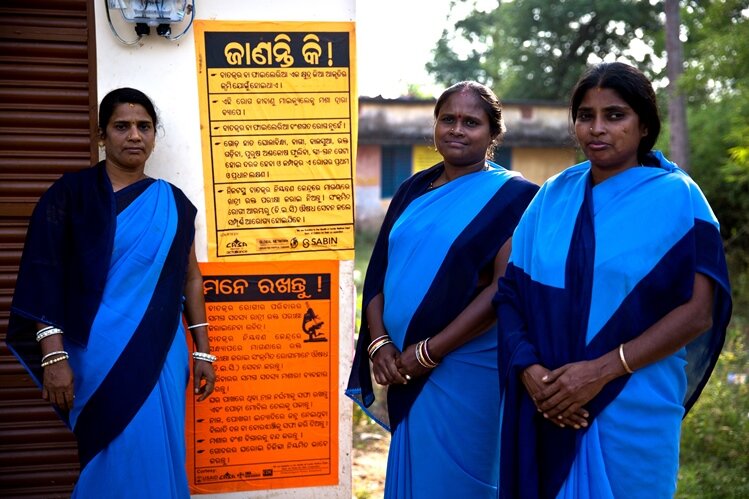by Dr. Madan Mohan Pradhan
During the late 1990s, I was infected with lymphatic filariasis (LF), or elephantiasis, a neglected tropical disease (NTD) that can cause extreme pain, crippling disability and disfigurement. LF is one of 17 NTDs recognized by the World Health Organization (WHO) as a group of parasitic and bacterial infections, which primarily affect people living in extreme poverty.
The incident occurred after I completed my medical degree. I was eager to work in Odisha and help some of its most vulnerable and under-served communities. It was during this time that I began working on an LF project, making nightly visits to endemic villages to collect blood samples from fevered patients. I knew how LF was transmitted, but had limited knowledge on the preventive aspect. As is typical in most cases, I didn’t present symptoms until years later. When I saw my right foot swelling with redness and pain four years later, I immediately diagnosed the disease and took the full course of diethylcarbamazine (DEC) tablets. I was cured and never had a recurrence again. Though I was fortunate enough to stop the disease at an early stage, many are not as lucky.
During my tenure as a medical officer in rural Odisha, I saw a number of patients with LF. Many of them lived in the poorest communities, with limited resources and support from their families. Social stigma and discrimination, along with misconceptions about transmission of the disease, often made matters worse.
As we observe National Filaria Week from December 14 to 20, it is important to raise greater awareness about this disease, which threatens nearly 352 million people in India. It is particularly important to know the source of transmission of LF. It is not caused by a curse or deeds from a past life. And it is not hereditary.
Lymphatic filariasis is caused by a tiny parasite, which is transmitted by Culex mosquitoes. Globally, more than 120 million people are affected by this disease. People living in poor environmental and unhygienic conditions are vulnerable to the infection as the Culex mosquito breeds in these places. Most LF infected people may not have any symptoms and are found apparently healthy. But the LF parasite can be transmitted from these asymptomatic people to healthy people through mosquitoes. LF affects the lymphatic channels of the body due to which there occurs swelling of breast, lymph nodes, genital organs, and at later stage these swellings can result in disfiguration.
Although LF isn’t fatal, it can lead to disfigurement, disability and chronic pain. As a result, many people with LF are unable to make a living for themselves and their families. Social stigma and discrimination also limit the quality of life for those affected by LF. It is not uncommon for parents to be unable to marry off children with LF.
To facilitate greater progress in combating the disease, the WHO launched a global program to eliminate LF by 2020. They adopted the intervention known as mass drug administrations (MDA), in which two drugs — DEC and albendazole tablets — are co-administered in a single dose. These drugs are cost-effective and safe, and can be administered by trained community volunteers.
If more than 85 percent of the eligible population of at-risk communities consume the drugs once annually for five to seven years, the risk of LF infection will be minimal to zero. That is why the Indian government has prioritized efforts to eliminate LF through the National Vector Borne Disease Control Programme.
Besides the MDA, there are other components for LF elimination and morbidity management, including hydrocele operations. Government and non-profits are working to increase the knowledge and skill of LF-affected persons and family members on home care. For the success of both MDA and morbidity management, community involvement, participation from other government departments and active involvement of civil society organisations is essential. This requires high level political and administrative commitment and raising awareness through community participation
In Odisha, the MDA will be conducted on December 19, followed by two days of mop up rounds. Following 10 districts: Deogada, Boudh, Angul, Dhenkanal, Bhadrak, Jajpur, Jagatsinghpur, Nayagarh, Ganjam and Jharsuguda will be covered under 2015 MDA. During this time, drug administrators such as ASHA workers and other community volunteers, will make door-to-door household visits to administer the two drugs used in MDA. They will explain the safety and importance of taking the drugs and ensure that people consume drugs after eating; and monitor any adverse effects. If we continue our momentum and efforts in Odisha, we can eliminate LF within the next few years. Together, we can help create a filaria-free reality in Odisha and India.
Dr. Madan Mohan Pradhan is the joint director of health services for the National Vector Borne Disease Control Programme in Odisha, India.
This story originally appeared in the Orissa POST and the Political and Business Daily.

